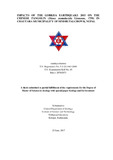Please use this identifier to cite or link to this item:
https://elibrary.tucl.edu.np/handle/123456789/1415| Title: | Impacts of the Gorkha Earthquake 2015 on the Chinese Pangolin (Manis Pentadactyla Linnaeus, 1758) in Chautara Municipality of Sindhupalchowk, Nepal |
| Authors: | Sharma, Sandhya |
| Keywords: | EARTHQUAKE;CHINESE PANGOLIN;Natural disasters;Wildlife Conservation;species |
| Issue Date: | Jun-2017 |
| Publisher: | Central Department of Zoology Institute of Science and Technology Tribhuvan University Kirtipur, Kathmandu |
| Abstract: | he Chinese Pangolin is a critically endangered species, enlisted in CITES, and protected by National Parks and Wildlife Conservation Act (1973) of Nepal, However, detail information on its occurrence, distribution and threats is not available. During June and July 2016, this study was conducted to investigate the impact of the Gorkha Earthquake 2015 on occurrence, distribution, and illegal trade of the species in Chautara Municipality. 75 plots of 100m*100m each were used to collect data on occurrence and distribution and interviewed 160 randomly selected respondents to assess the current threat and illegal trade of this species. The data were analyzed using logistic regression model. Data analysis showed the occurrence of the Chinese Pangolin was negatively associated with the mega earthquake (z= -2.769, p<0.05) and distance to settlement (z= - 3.590, p<0.05) while positively associated with farmland (z= 2.288, p<0.05) and south facing slope (z= 2.243, p<0.05). The average density of active burrows was two per hectare with the highest occurrence between the altitudes of 1201m to 1400m having Schima wallichii and Choerospordias axillaris as major tree species. The earthquake, poaching and illegal trade, and predators were perceived as the major threats by 51%, 23% and 11% of respondents respectively. Rasuwa and Kodari highways were identified as illegal trade routes for selling pangolins and their scales and other products. It was estimated that a total of 24kg-27kg of pangolin scales were sold to China market after the earthquake with an average price of Rs. 35,000 per kilogram. The earthquake impacted pangolins directly by killing them and damaging habitats and indirectly by increasing poaching and illegal trade. Both natural anthropogenic threats should be investigated further in the future while checking poaching through public awareness and strict law enforcement for the long term conservation of the species. |
| URI: | http://elibrary.tucl.edu.np/handle/123456789/1415 |
| Appears in Collections: | Zoology |
Files in This Item:
| File | Description | Size | Format | |
|---|---|---|---|---|
| Reviewed thesis.pdf | 2.42 MB | Adobe PDF |  View/Open |
Items in DSpace are protected by copyright, with all rights reserved, unless otherwise indicated.
